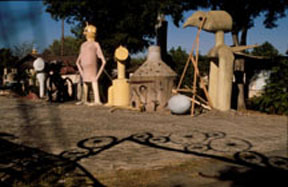

Along
a major
thoroughfare
in South
Sacramento,
past the
factories and
the
warehouses,
lies a
renegade
sculpture
park.
Nestled
behind a
cluster of
low walls,
fences and
surly
"Keep
Out"
signs is a
strange
accumulation
of homemade
statuary,
rusting
vehicles and
eccentric
buildings.
This cross
between a
surrealistic
miniature
golf course
and abandoned
farm
equipment
museum
belongs to a
chatty
ex-boxer and
antique
collector
named Duke
Cahill.
The Cahill
Fiberglass
Company
became the
site for
Duke's
growing
installation
of self-styled
sculptures
over 25 years
ago.
"I just
wanted to
build a
statue for
some
reason"
says Cahill
of his
original
inspiration,
a 20 foot
high spaceman
with a barrel
chest and
lighted
eyes.
But his wife
had other
ideas.
"She
told me 'If
you're going to build a
statue build
it out at
your work
yard, not at
my
house.'
Whenever my
men would get
off early I'd
have them
come out here
and we would
just start
building
something,"
he
said.
"We'd
utilize what
we had to
work with,
but you don't
know how it's
going to come
out.
Cahill's
homespun
creativity
could be
called
"folk
art," a
title
reserved for
people with
no formal art
training.
Others call
it
"outsider
art"
because it
rests just
outside the
mainstream of
what we
consider to
be fine
art.
But Duke
doesn't care
about
historical
categories.
When told one
of his
two-legged
creatures
looked like a figure in
Hieronymus
Bosch's
"Garden
of Earthly
Delights"
he was
amused, but had never
heard of the
artist.
 |
"Our
latest
statue
we
built
is a
woman,"
says
Cahill.
"She's
16
feet
high
and
her
breasts
light
up."
Refrigerators
and
water
tanks
are
often
used
for
the
understructure.
Then
plaster
and
fiberglass
sculpt
the
outer
shapes.
Cahill
says
some
if
the
inner
containers
are
stuffed
with
magazines,
newspapers
and
bottles,
so
that
"when
they
tear
this
place
down
someday,
there
are
going
to be
some
antiques." It's easy to get lost among the profusion of objects in Cahill's maze-like compound. Walking around with him and constant companion, Stubby the dog, I saw road signs, pitch forks, license plates, wrestling posters , boxing photographs, old vending machines, farm tools, caboose furnishings and an antique gas pump. |
| "Ever see a car like this?" he asks proudly pointing to a powder blue Cadillac that he converted into a pickup. | |
One
of the
attractions
on Cahill's
lot is a
converted
Navy landing
craft he
bought at an
auction.
His
groundskeeper
lives in that
building.
Another
building
features a
wall made out
of beer kegs
and a working
submarine
periscope on
the second
floor.
You can see
right into
windows of
the tract
houses across
the
street.
A stuffed
cowboy
holding a
shotgun sits
over on the
couch.
"That
came out of
the bad boy's
school
in
Ione,"
he says while
rousting a
cat from the
spiral
staircase.
A Sacramento
native,
Cahill earned
a living as a
heavyweight
boxer in the
1930's.
He boxed in
Australia for
three years,
purchasing
antiques and
shipping them
back
home.
During World
War II he was
a sailor in
the merchant
marine, but
continued to
box at
various ports
in the South
Pacific.
"Every
time we'd hit
an island I'd
challenge the
champion of
the
island.
None of those
big kids
could fight,
so I used to
bet all my
money on
myself."
Cahill says
he had a
pretty good
knockout
punch in
those days,
and his many
victories
provided the
means for
more antique
collecting.
| Hey kid, how about a shot of gin?" he asks from inside his workshop. "Sure thing, Duke." The walls are covered with thousands of small objects like hotplate grills, plastic dishware, liquor signs and original adages that he routed onto boards. One of them reads "If you're going to be stupid and smoke, be smart and clean your ashtray." |
|
Cahill once lent six of his metal sculptures--welded wagon wheel assemblages--to the Oakland Museum for a folk art exhibition. The sculptures traveled down to Los Angeles, then up to San Mateo, until he sent a worker to go fetch them back. "I didn't make those things so they could travel all over the country. I made them so I could look at them occasionally." This quote illustrates the irony of many folk artist that want in some way to show their works publicly while maintaining personal shyness and the desire for privacy. An art critic once wrote that " the best definition of a folk artist is one who isn't interested in fame." If so then Duke Cahill's unassuming nature makes him the perfect example.
-Ken Magri
Update:
Duke
Cahill passed
away in March
of 2003 at
the age of
82.
"He had
no
regrets,"
says friend,
artist and
gallery owner
Steve Vanoni.
"He told
me 'Kid, I've
had one hell
of a
life.'"
Over the last
few years
Vanoni has
labored
unselfishly
to preserve
the Cahill
legacy.
Hopes for
saving the
compound
ended when a
fire took
care of
several
buildings.
Some of the
metal
sculptures
have been
moved to a
friend's
estate.
A few will go
to Crocker
Art Museum
and the
Oakland
Museum of
Art.
The City of
Sacramento is
trying to
move the
large figure
sculptures.
"He was
full of great
stories and I
heard a lot
of
them,"
Vanoni told
me in a
recent phone
conversation.
Steve shot
lots of
footage of
the compound
that he is
hoping to
edit into a
documentary
about
Cahill.
Anyone
wanting to
learn more
about
Vanoni's
effort,
especially
those
interested in
supporting
it, can stop
by the
Gallery Horse
Cow at 1408
Del Paso
Boulevard, or
e-mail him by
way of the
gallery's web
site: www.sacforart.com/horsecow.html
-Ken Magri,
October, 2003